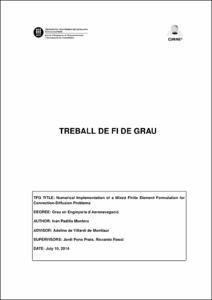Mostra el registre d'ítem simple
Numerical implementation of a mixed finite element formulation for convection-diffusion problems
| dc.contributor | Villardi de Montlaur, Adeline de |
| dc.contributor.author | Padilla Montero, Ivan |
| dc.date.accessioned | 2015-02-05T13:48:55Z |
| dc.date.available | 2015-04-17T11:47:01Z |
| dc.date.issued | 2014-07-17 |
| dc.identifier.uri | http://hdl.handle.net/2099.1/24972 |
| dc.description.abstract | This document aims to the numerical solution of convection-diffusion problems in a fluid dynamics context by means of the Finite Element Method (FEM). It describes the classical finite element solution of convection-diffusion problems and presents the implementation and validation of a new formulation for improving the accuracy of the standard approach. On first place, the importance and need of numerical convection-diffusion models for Computational Fluid Dynamics (CFD) is emphasized, highlighting the similarities between the convection-diffusion equation and the governing equations of fluid dynamics for incompressible flow. The basic aspects of the finite element method needed for the standard solution of general convection-diffusion problems are then explained and applied to the steady state case. These include the weak formulation of the initial boundary value problem for the convection-diffusion equation and the posterior finite element spatial discretization of the weak form based on the Galerkin method. After their application to the steady transport equation a simple numerical test is performed to show that the standard Galerkin formulation is not stable in convection-dominated situations, and the need for stabilization is justified. Attention is then focused on the analysis of the truncation error provided by the Galerkin formulation, leading to the derivation of a classical stabilization technique based on the addition of artificial diffusion along the flow direction, the so-called streamline-upwind (SU) schemes. Next, a more general and modern stabilization approach known as the Sub-Grid-Scale (SGS) method is described, showing that SU schemes are a particular case of it. Taking into account all the concepts explained, a new mixed finite element formulation for convection-diffusion problems is presented. It has been proposed by Dr. Riccardo Rossi, a researcher from the International Center for Numerical Methods in Engineering (CIMNE), and consists on extending the original convection-diffusion equation to a system in mixed form in which both the unknown variable and its gradient are computed simultaneously, leading to an increase in the convergence rate of the solution. The formulation, which had not been tested before, is then implemented and validated by means of a multiphysics finite element software called \texttt{Kratos}. Eventually, the obtained results are analyzed, showing the improved performance of the mixed formulation in pure diffusion problems. |
| dc.language.iso | eng |
| dc.publisher | Universitat Politècnica de Catalunya |
| dc.rights | Attribution-NonCommercial-ShareAlike 3.0 Spain |
| dc.rights.uri | http://creativecommons.org/licenses/by-nc-sa/3.0/es/ |
| dc.subject | Àrees temàtiques de la UPC::Aeronàutica i espai |
| dc.subject.other | Numerical implementation |
| dc.subject.other | Finite element method |
| dc.subject.other | Stabilization techniques |
| dc.subject.other | Mixed formulation |
| dc.subject.other | Convection-diffusion |
| dc.subject.other | Kratos |
| dc.title | Numerical implementation of a mixed finite element formulation for convection-diffusion problems |
| dc.type | Bachelor thesis |
| dc.rights.access | Open Access |
| dc.date.updated | 2014-07-18T08:48:08Z |
| dc.audience.educationlevel | Grau |
| dc.audience.mediator | Escola d'Enginyeria de Telecomunicació i Aeroespacial de Castelldefels |
| dc.audience.degree | GRAU EN ENGINYERIA D'AERONAVEGACIÓ (Pla 2010) |


